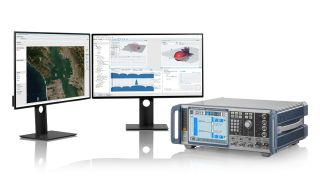Live field demonstrations
At the 2019 EW Live event in Tartu, Estonia, a radar simulator from Rohde & Schwarz was demonstrated live in an over-the-air (OTA) setup covering a free-space distance of 1.3 km to the ELINT and radar warning receivers (Figure 3).
The signal source was an R&S®SMW200A vector signal generator with two RF paths up to 20 GHz. It was controlled by the R&S®Pulse Sequencer software. Four compact R&S®SGT100A RF sources were also integrated into the system to simulate additional radars below 6 GHz. This setup allowed the creation of scenarios involving ten simultaneous radar emitters.
Figure 4 shows a simulator signal plan. The R&S®SMW200A vector signal generator’s large internal modulation bandwidth of 2 GHz makes it possible to generate radar signals from multiple emitters in a single RF path. In this scenario, the R&S®SMW200A generates six radar signals simultaneously (three in RF path A and three in RF path B). Each R&S®SGT100A generates one additional radar signal.
Signals from radar systems with operating frequencies between 5 GHz and 6 GHz were simulated in RF path A,while RF path B was used to generate radar signals in the 9 GHz range. Splitting radar signal generation between two paths makes it is possible to create very realistic scenarios, including those with colliding pulses and highest dynamic range.
The signal plan defines different radar signal types, from simple, unmodulated pulses to complex I/Q modulated pulses (e.g. AMOP, FMOP, PMOP, chirps and Barker coded pulses). Diverse interpulse modulation profiles such as pulse repetition interval (PRI) staggering and frequency hopping are also used. Also included is a complex multimode radar featuring frequency agile and time agile operations as well as diverse antenna patterns and scans.
For the EW Live demonstration, the R&S®SMW200A and R&S®SGT100A vector signal generators turned into a fullfeatured radar simulator, thanks to their flexibility and powerful performance. The vector signal generators are standard commercial-off-the-shelf products. They enable high performance field tests at relatively low cost and with little effort. Added benefits include quick and easy installation anywhere and performance verification for the systems tobe tested.












